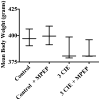Group 1 mGlu-family proteins promote neuroadaptation to ethanol and withdrawal-associated hippocampal damage
- PMID: 26442908
- PMCID: PMC4633372
- DOI: 10.1016/j.drugalcdep.2015.09.013
Group 1 mGlu-family proteins promote neuroadaptation to ethanol and withdrawal-associated hippocampal damage
Abstract
Background: Group 1 mGlu-family proteins (i.e., mGlu) consist of mGlu1 and mGlu5 and their activity may influence voluntary ethanol intake. The present studies sought to examine the influence of these receptors on the development of ethanol dependence using in vitro and in vivo models of chronic, intermittent ethanol (CIE).
Methods: Rat hippocampal explants were exposed to CIE with or without the addition of mGlu1 antagonist (7-hydroxyimino)cyclopropa[b]chromen-1a-carboxylate ethyl ester (CPCCOEt; 0.5, 1, and 3μM) or mGlu5 antagonist (E)-2-methyl-6-styryl-pyridine (SIB-1893; 20, 100, and 200μM) to assess sparing of withdrawal-induced cytotoxicity. In a separate study, adult male rats were administered CIE with or without the addition of oral administration of group 1 mGlu antagonist 2-methyl-6-(phenylethynyl)-pyridine (MPEP; 3mg/kg). Blood ethanol levels (BELs) were determined at 0930h on Day 2 of Weeks 1, 2, and 3. Withdrawal behavior was monitored during Day 6 of the third consecutive withdrawal.
Results: CIE produced significant hippocampal cytotoxicity. These effects were attenuated by co-exposure to CPCCOEt (3μM) with ethanol in the CA3. By contrast, these effects were blocked by SIB-1893 (20μM) in each primary cell layer. Oral administration of MPEP with ethanol significantly attenuated behavioral effects of subsequent withdrawal and reduced BELs.
Conclusions: These data demonstrate that ethanol activates group 1 mGlu-family proteins to promote withdrawal-associated cytotoxicity in vitro and physical dependence in vivo. These findings suggest that group 1 mGlu-family proteins may be therapeutic targets for treatment of alcohol use disorders.
Keywords: CIE; Chronic intermittent ethanol; Metabotropic glutamate receptor; NeuN; Neuron specific nuclear protein; mGlu.
Copyright © 2015 Elsevier Ireland Ltd. All rights reserved.
Conflict of interest statement
Figures






Similar articles
-
The influence of various glutamate receptors antagonists on anxiety-like effect of ethanol withdrawal in a plus-maze test in rats.Eur J Pharmacol. 2008 Nov 19;598(1-3):57-63. doi: 10.1016/j.ejphar.2008.09.026. Epub 2008 Sep 27. Eur J Pharmacol. 2008. PMID: 18838071
-
Ethanol withdrawal is required to produce persisting N-methyl-D-aspartate receptor-dependent hippocampal cytotoxicity during chronic intermittent ethanol exposure.Alcohol. 2015 May;49(3):219-27. doi: 10.1016/j.alcohol.2015.01.008. Epub 2015 Feb 7. Alcohol. 2015. PMID: 25746220 Free PMC article.
-
Endogenous activation of group-I metabotropic glutamate receptors is required for differentiation and survival of cerebellar Purkinje cells.J Neurosci. 2001 Oct 1;21(19):7664-73. doi: 10.1523/JNEUROSCI.21-19-07664.2001. J Neurosci. 2001. PMID: 11567056 Free PMC article.
-
Glutamate metabotropic receptors as targets for drug therapy in epilepsy.Eur J Pharmacol. 2003 Aug 22;476(1-2):3-16. doi: 10.1016/s0014-2999(03)02149-6. Eur J Pharmacol. 2003. PMID: 12969743 Review.
-
Metabotropic glutamate receptor subtypes as targets for neuroprotective drugs.J Cereb Blood Flow Metab. 2001 Sep;21(9):1013-33. doi: 10.1097/00004647-200109000-00001. J Cereb Blood Flow Metab. 2001. PMID: 11524608 Review.
Cited by
-
Sintocalmy, a Passiflora incarnata Based Herbal, Attenuates Morphine Withdrawal in Mice.Neurochem Res. 2021 May;46(5):1092-1100. doi: 10.1007/s11064-021-03237-w. Epub 2021 Feb 5. Neurochem Res. 2021. PMID: 33544325
-
Metabotropic and ionotropic glutamate receptors as potential targets for the treatment of alcohol use disorder.Neurosci Biobehav Rev. 2017 Jun;77:14-31. doi: 10.1016/j.neubiorev.2017.02.024. Epub 2017 Feb 24. Neurosci Biobehav Rev. 2017. PMID: 28242339 Free PMC article. Review.
-
Heavy Alcohol Exposure Activates Astroglial Hemichannels and Pannexons in the Hippocampus of Adolescent Rats: Effects on Neuroinflammation and Astrocyte Arborization.Front Cell Neurosci. 2018 Dec 4;12:472. doi: 10.3389/fncel.2018.00472. eCollection 2018. Front Cell Neurosci. 2018. PMID: 30564103 Free PMC article.
-
Critical needs in drug discovery for cessation of alcohol and nicotine polysubstance abuse.Prog Neuropsychopharmacol Biol Psychiatry. 2016 Feb 4;65:269-87. doi: 10.1016/j.pnpbp.2015.11.004. Epub 2015 Nov 12. Prog Neuropsychopharmacol Biol Psychiatry. 2016. PMID: 26582145 Free PMC article. Review.
-
Ethanol Stimulates Endoplasmic Reticulum Inositol Triphosphate and Sigma Receptors to Promote Withdrawal-Associated Loss of Neuron-Specific Nuclear Protein/Fox-3.Alcohol Clin Exp Res. 2016 Jul;40(7):1454-61. doi: 10.1111/acer.13097. Epub 2016 May 14. Alcohol Clin Exp Res. 2016. PMID: 27177604 Free PMC article.
References
-
- Backstrom P, Bachteler D, Koch S, Hyytia P, Spanagel R. mGluR5 antagonist MPEP reduces ethanol-seeking and relapse behavior. Neuropsychopharmacology. 2004;29:921–928. doi:101038/sjnpp1300381. - PubMed
-
- Becker HC. Animal models of excessive alcohol consumption in rodents. Curr Top Behav Neurosci. 2013;13:355–377. - PubMed
-
- Berkeley JL, Levey AI. Cell-specific extracellular signal-regulated kinase activation by multiple G protein-coupled receptor families in hippocampus. Mol Pharmacol. 2003;63:128–135. - PubMed
Publication types
MeSH terms
Substances
Grants and funding
LinkOut - more resources
Full Text Sources
Other Literature Sources
Miscellaneous

